While sheep’s milk is hard to find, you’re likely to bump into sheep cheese in most grocery stores. Surprisingly, you may have consumed sheep cheese unknowingly as many imported cheeses are made from sheep milk.
Sheep milk cheeses differ in terms of flavor and texture. You should also note that sheep milk is richer in healthy fats and protein than cow’s milk. The high-fat content makes this cheese feel creamy.
Additionally, this type of cheese is low in calcium, which means it doesn’t easily get contaminated during the cooling process.
Read on to learn more about the different types of cheese made from sheep milk.
Table of Contents
6 Types of Sheep Milk Cheese
Sheep milk cheese features different flavors. Whether you’re looking for a tangy taste, sweet, or nutty, there’s an option for everyone.
Some of the common types include:
1. Manchego
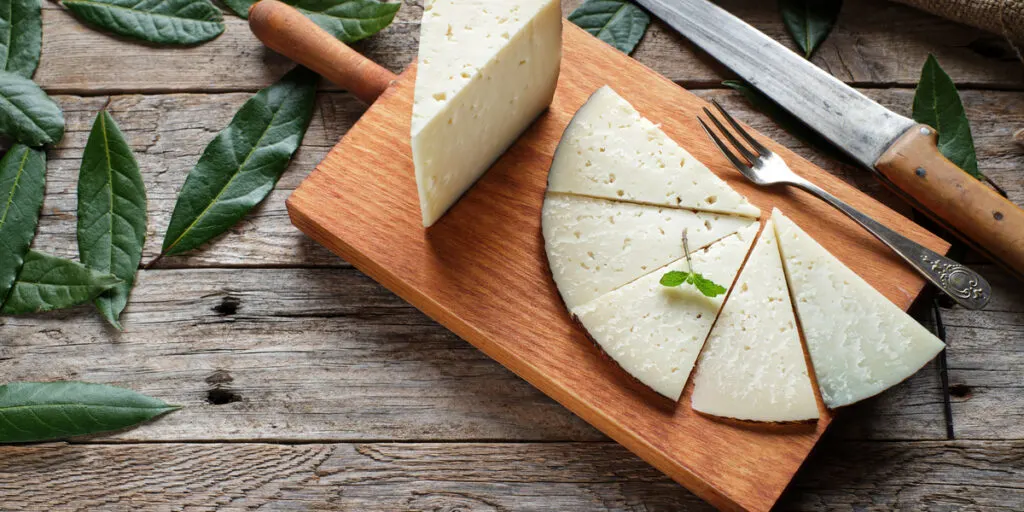
Manchego is one of the popular types of sheep milk cheese. It’s originally from the region of La Mancha, Spain.
It’s made from Manchega sheep’s milk. These sheep are raised in the La Mancha region. You can find two types of Manchego cheese, mainly the industrial types made with pasteurized or unpasteurized milk, and the farmhouse version made with unpasteurized sheep’s milk.
Young manchego cheese is supple and moist. It has a creamy and pale color. You’ll notice that younger manchego versions have a slight sour cream taste. Some have a tangy flavor with hints of fruit and grass.
Mature manchego cheese has a dry and crumbly texture. Its butterscotch color makes it easily recognizable. Additionally, this type of cheese has a mellow taste with hints of nuts and caramel. It’s sweeter but still retains acidity.
You can pair your manchego cheese with fig cake or enjoy it with a glass of fino sherry. The cheese can be used in savory pastries and sandwiches. It can also be added to eggs and salads.
Note that manchego cheese is PDO certified and protected. That means real manchego cheese has a seal to indicate its authenticity.
2. Roquefort
Roquefort is a soft blue cheese made from sheep milk. The popular French cheese was originally known as Emperor Charlemagne’s favorite cheese and was referred to as the cheese of kings and popes.
The cheese is protected by AOC guidelines, which are part of French laws. That means that only cheese processed in Roquefort should be labeled Roquefort cheese. Other French cheeses are known as bleu cheese.
Roquefort cheese is made from unpasteurized sheep milk and then combined with salt and rennet. The curd is then inoculated with penicillium spores and the mixture rests for at least two hours. The cheese is aged for three to nine months.
The original Roquefort has a salty, sharp, and tangy flavor with a creamy, rich texture. It’s recognizable by its white to pale yellow color and moist, but crumbly texture.
Roquefort is commonly used in dressings and as a salad topping. You can also pair it with quiches and pasta dishes. It makes a great filling for tarts and pies. Some people like pairing Roquefort with dry red wine.
The cheese can also be served as part of a cheese platter or paired with dried or fresh fruits.
3. Ossau-Iraty
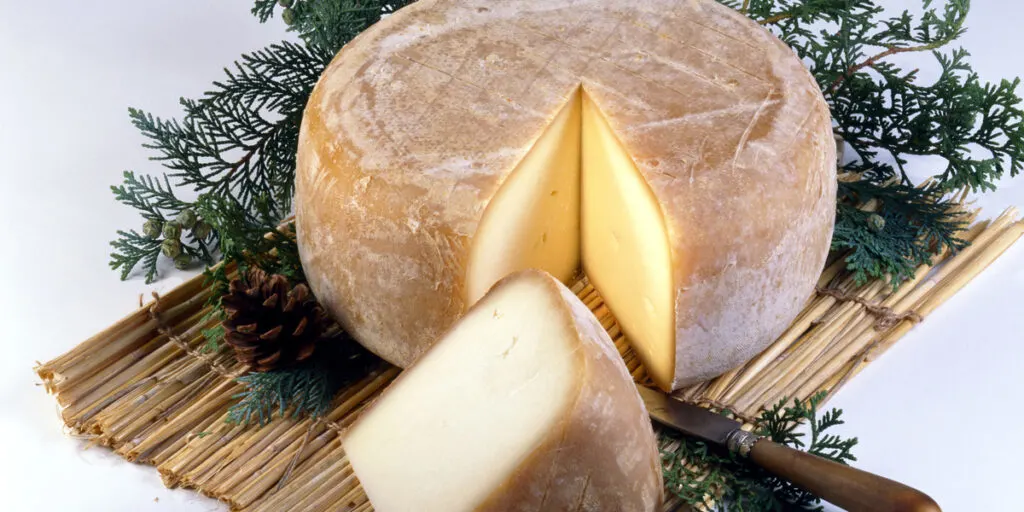
Ossau-Iraty is a type of unpasteurized cheese with its origin in the Northern Basque region of France. Like Roquefort cheese, Ossau-Iraty is also AOC-certified.
While it’s not as popular, Ossau-Irarty is considered the father of the Basque cheeses, dating back to 3,000 B.C. The cheese gets its name from two regions, Ossau in the valley of Bearn and Iraty in the beech forests of the Pays Basque.
The cheese is made from unpasteurized sheep’s milk that comes from brebis sheep.
Ossau-Iraty cheese has a dense and smooth texture that is still supple. It also has a nutty and sweet flavor, with notes of cellars. Some have a grass flavor with vegetal notes, especially when made during summer.
It has an ivory color with a dry thick rind that can be dark brownish gray or orangish-yellow color.
You can serve the cheese as a table cheese or you can add it to an antipasti platter. The cheese also pairs well with dry crisp whites or bold, earthy red wines.
The French also like to serve the cheese with cured meats like dry sausages, a fruit plate, or fresh vegetables.
4. Ricotta
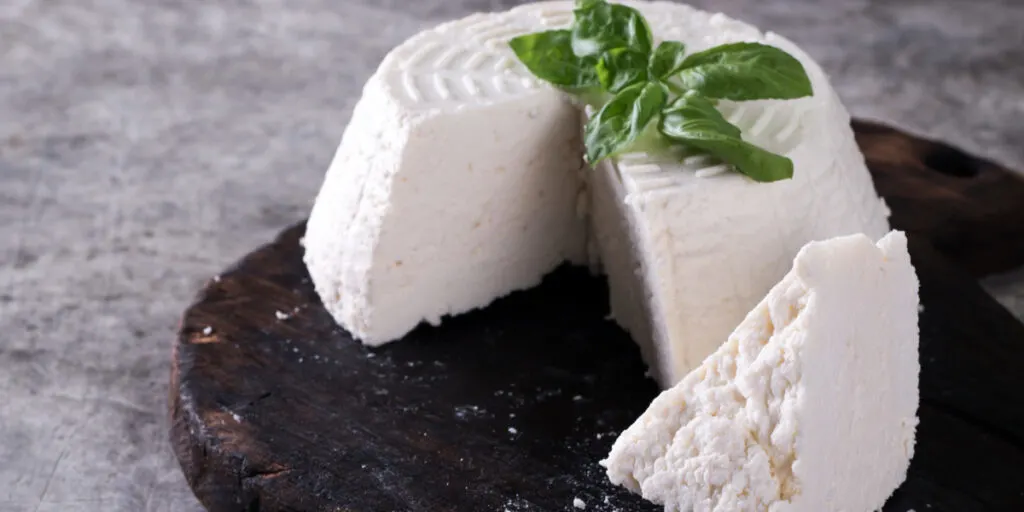
Ricotta cheese is made from the whey remaining after producing sheep’s milk cheeses. Then the whey is re-cooked at a temperature of 195°F. The cheese may be salted or smoked. It is also prepared for storage or it can be made fresh.
Although modern Ricotta may be made with whey some people mix in whole cream or milk to give the cheese a creamy texture and boost its fat content.
Ricotta is originally from Italy and features a grainy texture. It’s low in fat and has a sour cream-like flavor.
Ricotta cheese is widely used in Italian cuisines like manicotti, ravioli, lasagna, and other types of dishes. It’s also used as a filling in cakes or can be substituted for mayonnaise in sandwiches.
Ricotta cheese is available in part-skim and whole milk versions. It’s also available in Italian groceries as a special treat. The cheese is best kept wrapped in the fridge and used within two days.
5. Feta
Feta cheese is another type of cheese made from sheep’s milk. Some recipes combine sheep’s milk with goat’s milk. The cheese is popular for its slightly sour taste and pungent aroma.
Originally from Greece, Feta cheese has a crumbly texture and is lower in fat compared to other types like Parmesan or cheddar cheese.
You can use Feta in salads due to its crumbly texture. It also makes an excellent alternative to shredded cheese on pizzas.
Sprinkling it on roasted vegetables gives them a unique flavor. Feta cheese can also be served on an appetizer plate with sliced meats, slices of bread, and olives.
If you’re looking to add texture to your savory pastries, baked casseroles, or stews, Feta cheese is a perfect addition as it never melts fully in hot dishes.
When storing Feta cheese, include some brine before storage to ensure it remains fresh in the fridge. The cheese can also be frozen to avoid losing its quality.
6. Wigmore
Wigmore cheese is another cheese made from young sheep’s milk. This cheese was first made by Anne Wigmore in 1986 and sometimes includes whey to give it a unique texture.
The cheese has a rich, fruity, and complex flavor with a smooth texture. Unlike other types of cheese, Wigmore cheese uses hand-washed curd cheese, a process that reduces acidity, that allows the cheese to retain its mild taste and smooth texture.
Young Wigmore cheese is crumbly but matures to a velvety texture with melting edges. Mature Wigmore cheese also has hints of nuts and caramel, a combination that creates a delicate flavor.
You can pair your Wigmore cheese with a Cabernet Merlot. It also works well as a sweet aperitif and can be combined to create a dessert due to its fruity flavors.
7. Idiazabal

Idiazabal cheese is a type of cheese made from unpasteurized sheep milk. The traditional hard cheese is made from Carranza or Latxa sheep that are originally from Spain.
The cheese gets its name from the village of Idiazabal, where the production of this type of cheese started. Modern cheesemakers allow Idiazabal cheese to mature for two months, they later smoke it using alder or beech wood.
Characterized by a cylindrical shape and smooth rind, Idiazabal cheese has a compact and dry texture. The cheese has a burnt caramel-like flavor that is believed to be a result of storing the cheese near a fireplace for an extended period.
Idiazabal cheese has a yellow or beige color, while its piquant and acidic flavor gives it’s a unique taste.
The cheese pairs well with dry cider or saison.
8. Pecorino Romano
Pecorino Romano cheese is a salty and hard Italian cheese made with sheep’s milk. The cheese is available in large cylinders with a yellow rind that encases a whitish interior. It features a grainy and crumbly texture and has a pale straw color.
Its intense salty flavor is one distinguishing factor that makes Pecorino Romano ideal for grating.
Most Pecorino Romano cheeses are unpasteurized and gluten-free. However, they have animal rennet, which means they are not vegan friendly.
You can sprinkle Pecorino Romano on your stews, soups, patties, pizza, salads, and pasta. The cheese also acts as a salty condiment over potatoes, bread, and roasted vegetables. Some Italians mix Pecorino Romano cheese with another meting cheese and use it in gratins and casseroles.
9. Casu Marzu

Casu Marzu is originally from Sardinia island and it’s made from sheep’s milk. The term Casu Marzu refers to rotten cheese as the cheese has live maggots that help with the decomposition.
The cheese is part of the Pecorino family and is one of the softest sheep cheeses. However, it’s also considered illegal and the most dangerous cheese in the world. Most Sardinians slather the cheese on flatbread, while some enjoy it with red wine.
10. Halloumi
Halloumi is an unripened, semi-hard Cypriot cheese made from goat and sheep’s milk. The cheese has a rubbery texture and is stretchy. It’s similar to mozzarella cheese and can also be made from cow’s milk.
Its salty and tangy flavor is close to feta and mozzarella cheese.
While you can eat the cheese raw, most people prefer to use it for frying and grilling. When grilled, Halloumi has a savory and crispy taste and tends to melt on the inside.
Halloumi cheese has a high melting point, which means that it warms up but doesn’t melt completely. That makes it perfect for sandwiches, appetizers, and some vegetarian dishes.
You can also layer it in salads. In Cyprus, the cheese is served with watermelon as a tradition.
11. Testouri
Testouri is a type of cheese made from goat and sheep milk. It has a shape similar to an orange and can be eaten fresh or you can add some salt to it.
The cheese was introduced into North Africa in the 15th century by the Ottomans, and it’s now a popular delicacy in the east.
12. Caciotta
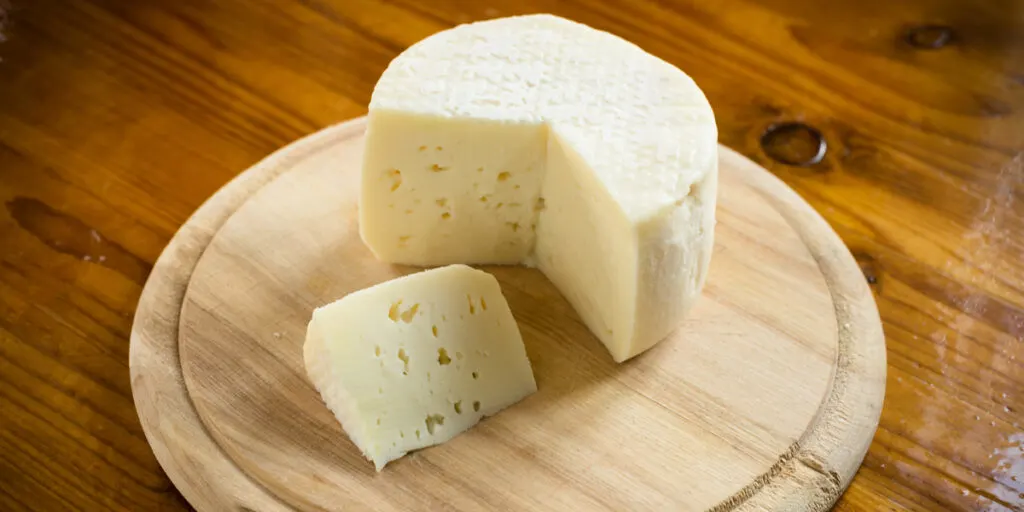
Caciotta is a semi-aged soft cheese that was made with sheep milk during the cold season and prepared with other types of milk in other seasons. The cheese was introduced as an alternative to Pecorino Romano, with the focus on making it delicate and sweet.
Originally from Italy, Caciotta has a firm, creamy, and compact texture and a pale yellow color. It’s also tangy, sweet, and mild.
You can season and flavor your Caciottta cheese with other ingredients. The cheese can also be paired with aromatic herbs, onion, and black pepper.
13. Brocciu
Brocciu is made from pasteurized sheep or goat milk. The cheese is originally from Corsica, France, and means cheese made from ewe’s milk.
It’s served as a lactose-free alternative to Ricotta, an Italian cheese. Being considered food on the island, the cheese has an AOC quality label.
Brocciu fully matures in a couple of weeks to a month with a milky aroma and a unique sweet flavor.
You can use this cheese as the main ingredient in soups, omelets, pastries, and vegetable recipes.
14. Etorki
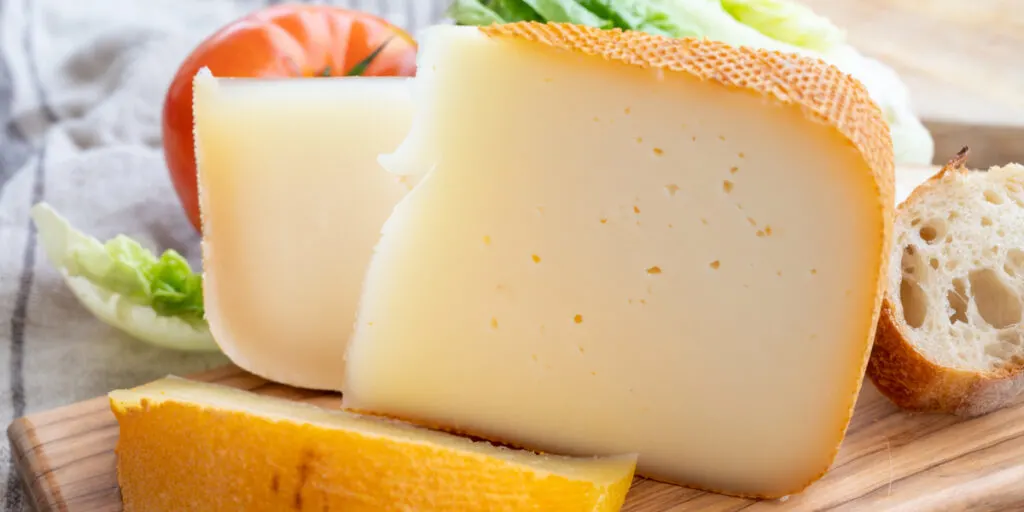
Etorki is a French type of cheese made from pasteurized sheep’s milk. Unlike other types of cheeses, Etorki is not cooked. Its pulp is pressed and left to mature for seven weeks.
The cheese has a bumpy rind and a supple interior. Etorki has an earthy aroma that resembles a caramel flavor. Its interior paste has a golden color and has slits due to the pulp pressing.
You can pair Etorki cheese with sparkling white wine, chardonnay, or riojas.
Final thoughts
Cheese made from sheep’s milk has varying characteristics, texture, and flavor undertones. Unlike cow’s milk cheese, sheep milk cheese has high-fat content, but it’s low in calcium.
Hopefully, you now have an idea of some of the common types of sheep milk cheese around and their characteristics.
Sources
- https://en.wikipedia.org/wiki/Manchego
- https://www.cheese.com/manchego/
- https://www.masterclass.com/articles/roquefort-cheese-guide#how-to-enjoy-roquefort-cheese
- https://www.stamfordcheese.com/product/wigmore-cheese
- https://en.wikipedia.org/wiki/Casu_martzu
- https://www.thespruceeats.com/what-is-halloumi-cheese-3376845
